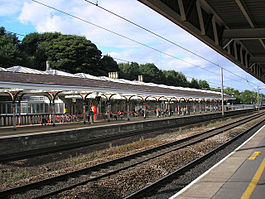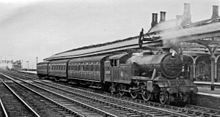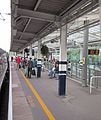- Durham railway station
-
Durham 

Location Place Durham Local authority Durham Coordinates 54°46′47″N 1°34′53″W / 54.7798°N 1.5815°WCoordinates: 54°46′47″N 1°34′53″W / 54.7798°N 1.5815°W Operations Station code DHM Managed by East Coast Number of platforms 2 Live arrivals/departures and station information
from National Rail EnquiriesAnnual rail passenger usage 2004/05 * 1.650 million 2005/06 *  1.740 million
1.740 million2006/07 *  1.774 million
1.774 million2007/08 *  1.858 million
1.858 million2008/09 *  1.996 million
1.996 million2009/10 *  2.051 million
2.051 millionNational Rail - UK railway stations A B C D E F G H I J K L M N O P Q R S T U V W X Y Z * Annual passenger usage based on sales of tickets in stated financial year(s) which end or originate at Durham from Office of Rail Regulation statistics. Please note: methodology may vary year on year. Durham railway station serves the city of Durham on the East Coast Main Line. The railway station is managed by East Coast. Despite its small functional capacity the station is a principal stop on the East Coast Main Line and is called at by many intercity services travelling the route.
The travel time between Durham and London King's Cross, 254 miles (409 km) south, is around three hours on a high-speed East Coast service.
Contents
Description
Durham is a through station with two platforms and is located on a hill to the north of the city centre. To the south of the station, the railway line is elevated on a viaduct. After the 2006–2008 renovation, the booking hall is now located in the original stone station building.
History
Originally, Durham was served by three stations but none of these survive today. Only one of these was located in the city. This was built at Gilesgate and served a branch from the Leamside Line (then the main line from London to Newcastle). The other two were in nearby Shincliffe, one called Shincliffe Town which served a branch from Sunderland which was built in 1839, and the other (Shincliffe Bank Top) was opened in 1844. The Sunderland branch was later extended into Durham city at a station called Elvet in 1893, and Shincliffe Town declined in importance and eventually closed.
In 1857, the current Durham railway station and the viaduct immediately to the south were built, but it was not on the main line. It was built as a terminus to a branch from Bishop Auckland. However, in 1871 a new line was built from the existing main line at Tursdale to the new Durham station, then continued to Newcastle Central via Chester-le-Street. This soon became the main line.
The Gilesgate branch closed in 1965. Passenger services to Newcastle via the Leamside route ended in 1963; the Leamside line declined in importance, and was mothballed in 1991. Passenger services to Bishop Auckland and Sunderland via Penshaw were withdrawn on 4 May 1964.
The other stations in Durham and Shincliffe closed to passengers before the Beeching Axe, but many remained goods stations until the closures. Prior to the nationalisation of the railways, it[clarification needed] was run by London and North Eastern Railway. The line was electrified in 1991. Today, the station is owned by Network Rail and managed by East Coast.
2006–2008 refurbishment
The station was refurbished between 2006 and 2008 by operator GNER and later National Express which included a new lounge, toilets, travel centre, glazed waiting area, lifts and shops. The entrance and booking hall were moved from the 'temporary' 1960s building into the original stone building following renovation and repairs. The renovations were completed in early 2008 and the newly renovated station won Best Medium Station and Overall Station of the Year at the 2008 National Rail Awards.[1]
Services
Direction East Coast CrossCountry First Transpennine Express Northern Rail Northbound 1tph to Newcastle, with some continuing to Edinburgh 1tph to Newcastle
1tph to Edinburgh1tph to Newcastle 3tpd to Newcastle in the early morning 2t on Saturday Southbound 1tph to London Kings Cross 1tph to Reading via Doncaster
1tph to Plymouth via Leeds1tph to Manchester Airport 1tpd to Middlesbrough in the late evening on Saturday and Sunday tph = trains per hour tpd = trains per day
Gallery
References
External links
- Train times and station information for Durham railway station from National Rail
Preceding station  National Rail
National RailFollowing station CrossCountry First TransPennine Express Darlington East Coast
East Coast Main LineNewcastle Railway stations in County Durham (London Kings Cross) → → Darlington • Aycliffe (closed) • Ferryhill (closed) • Durham • Chester-le-Street → → (Edinburgh Waverley)(Newcastle Central) → → Seaham Colliery (closed) • Seaham • Easington • Horden • Blackhall Rocks • Hartlepool • Seaton Carew • Greatham (closed) • Billingham • Stockton → → MiddlesbroughBishop Auckland • South Church (closed) • Shildon • Newton Aycliffe • Heighington • North Road • Darlington • Dinsdale • Tees-side Airport • Allens West • Eaglescliffe • Thornaby • Newport (closed) • Middlesbrough • Cargo Fleet (closed) • South Bank • Grangetown (closed) • British Steel Redcar • Warrenby Halt (closed) • Redcar Central • Redcar East • Longbeck • Marske • SaltburnBishop Auckland • Witton Park (closed) • Wolsingham • Frosterley • Stanhope • Eastgate (closed) • Westgate (closed) • St Johns Chapel (closed) • Wearhead (closed)Former railway linesClarence RailwayRedmarshallDarlington and Tebay BranchDarlington • North Road • Piercebridge • Gainford • Winston • Broomielaw • Barnard Castle • Lartington • Hulands • Bowes → → (Tebay)(Swalwell, Tyne and Wear) → → Lintz Green • High Westwood • Ebchester • Shotley Bridge • BlackhillLanchester Valley railway
(incomplete)Durham • Aldin Grange for Bearpark • Witton Gilbert • LanchesterAnnfield Plain DeviationPelton • Beamish • West Stanley(Sunniside, Tyne and Wear) → → Andrews House • Causey Arch • East TanfieldCategories:- Railway stations in County Durham
- Former North Eastern Railway (UK) stations
- Railway stations opened in 1857
- Railway stations served by CrossCountry
- Railway stations served by First TransPennine Express
- Railway stations served by East Coast
- Railway stations served by Northern Rail
- DfT Category C1 stations
Wikimedia Foundation. 2010.







